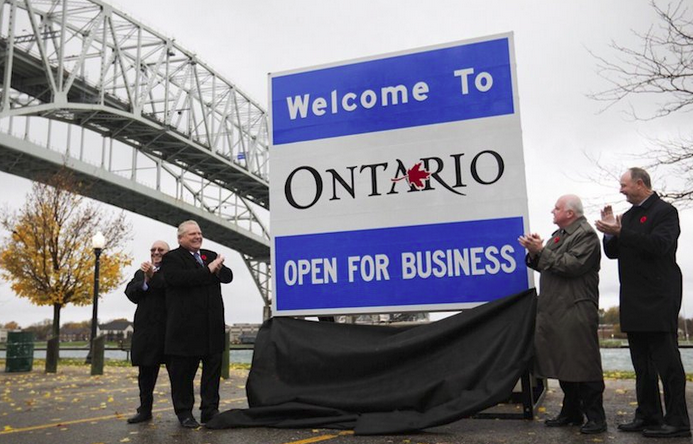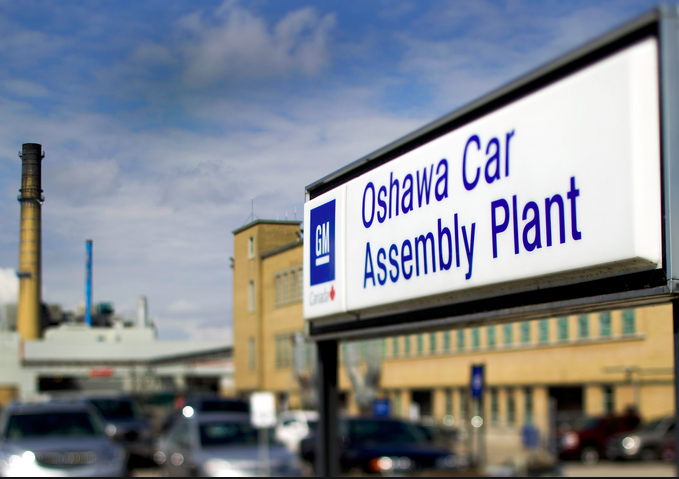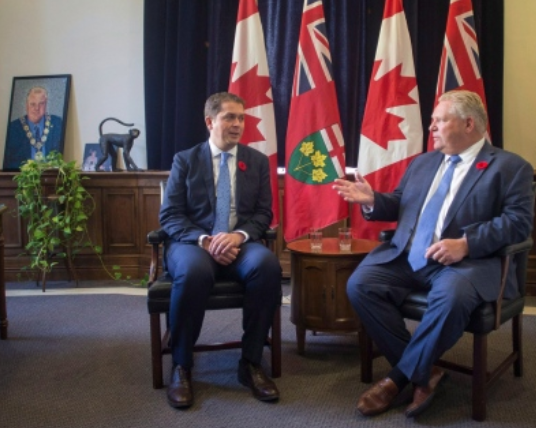 By Ray Rivers
By Ray Rivers
November 29th, 2018
BURLINGTON, ON
It is nothing short of dishonest for federal Conservative leader Andrew Scheer to blame the announced closing of General Motors (GM) operations in Oshawa next year on a federal carbon tax – which has yet to be implemented. It is equally dishonest for the Ontario premier to be running around blaming everything on the policies of the previous Liberal government.

One of the bigger business operations in the province had decided to leave. There was nothing the province could do to keep them.
GM was clear that this was a corporate-wide restructure which is closing at least one plant in Canada and several more in the USA. It has to do with excess production capacity for gas guzzlers and the company’s failure to adjust to changing markets. And nothing Mr. Ford could offer, be it lower taxes, lower electricity rates, fewer labour regulations or a cash grant, would make the company change its mind. Ford was told definitively by GM’s management, as they hung up the phone – ‘the ship has left the dock’.
The traditional big three North American auto giants, and GM in particular, are chronic slow learners and always late to the game. The first electric car was invented by a Hungarian dude back in the early 1800s, over half a decade before Mr. Benz patented the first gas guzzler. By the turn of the century there were almost twice as many electric as petroleum vehicles on the road in America. But cleanliness, simplicity of operation and fast acceleration eventually lost out to the increased range and the lower costs of the more complicated Model T.
GM is not fondly remembered for its own history with electricity. In response to California’s emerging tough fuel and emissions standards in the 1990s, the company piloted the EV1 project. Everybody who drove one loved the car but for some suspicious reason GM killed the project and destroyed the cars anyway.
Two decades later, to compete with the Prius hybrid, the Chevy Volt, a miserable compromise of inadequate battery range and an inefficient on-board gasoline charging system, showed up. Its ultimate demise this coming year will result in few tears. Only last year GM finally got the memo and produced the all-electric Chevy Bolt with a battery range into Tesla territory. These cars are built in Michigan and their batteries in Korea.

Neither our governments nor the company saw the writing on the wall – that doing the same things will give you the same result.
It was barely a decade ago when, as GM nearly folded-up camp, it came cap-in-hand to the Canadian and US federal and sub-national governments, begging for a handout to ride out the GW Bush recession. Canada and Ontario wasted no time asking how much, and we ended up with a combination of loans and equity totaling almost $14 billion.
The US set specific environmental conditions before issuing the lending instruments and ultimately got all of its money back and then some. The Harper government sold off our equity early in order to present a balanced budget for the 2015 election, and ended up losing $3.5 billion as a result.
In addition there was apparently a billion dollars which had been signed over to a GM entity which no longer exists. There was some kind of ‘old GM’, as opposed to a “new GM“ and the new one isn’t about to pay the money back. This for a company which earned over six billion in profits last year.
Cars are like a narcotic. If GM is a junkie then our governments are the the enablers, feeding its habits and ignoring the consequences. Neither our governments nor the company saw the writing on the wall – that doing the same things will give you the same result. Instead of sending the company to rehab, the governments just benignly encouraged GM to keep doing business as usual – making the same old cars – the same old mistakes.
GM claims the 60 year old Oshawa plant is unsuitable for production of the new generation of EVs and autonomous diving cars. Indeed the facility may be old but isn’t a car a car? Auto companies regularly run different models on the same assembly line. GM is doing that now, building trucks on a line formerly used for sedans.
And why have we all been blindsided by this closure announcement? The company has a contract with its labour union which extends beyond the planned closure date, surely the union should have been consulted. The union president is convinced GM is on a path to also close the other two factories it operates in Canada. What does that hold for the security of pension and benefit obligations?

The Leggat family have been in the car retailing business for a long long time.
GM was once Canada’s largest auto maker. Does its executive brain trust think there will be any remaining buyer loyalty after this caper? Once the dust has settled GM might as well take their dealership operations with it if it closes the door on Canadian production. The union boss, Jerry Dias, wants Mr. Trudeau and Mr. Trump to impose a 40% tariff on GM cars built in Mexico and China. That would teach it a lesson Dias says.
We know little of GM’s corporate decision making process, but perhaps somebody should have listened when it warned that Donald Trump’s recent tariffs would end up in a smaller GM. Trump’s reaction to the US plant closures, threatening to remove the federal subsidies for buyers of GM EVs, is as wrong headed as his tariffs were. Those EVs are currently built in America, after all.
GM claims that it has seen the light, joining Ford Motors, Volkswagen and others in shifting from gasoline to EV production. Once upon a time, six months ago, Ontario buyers used to get a provincial incentive for new EVs, as buyers do in several other jurisdictions across Canada and throughout the USA. And a carbon tax raising the cost of gasoline would encourage more car buyers to join the EV crowd. These policies are consistent with the direction the new GM is heading.

Leader of the federal opposition Andrew Scheer with Ontario Premier Doug Ford. Note the picture to the left of former Toronto Mayor the late Rob Ford
But it doesn’t sound like retaining those Wynne government pro-EV policies would have kept the Oshawa plant open any more than Mr. Ford’s killing them did. Scheer and Ford need to take a step back and re-examine their own policies before they heap unwarranted blame on their political opponents.
Pointing fingers and slinging mud are unhelpful at this time. And putting up signs saying ‘Ontario is open for business’ is a waste of time when the business model the government is using dates back at least thirty years. Like the evolution of the automobile its past time to move into the 21st century.
 Ray Rivers writes regularly on both federal and provincial politics, applying his more than 25 years as a federal bureaucrat to his thinking. Rivers was once a candidate for provincial office in Burlington. He was the founder of the Burlington citizen committee on sustainability at a time when climate warming was a hotly debated subject. Ray has a post graduate degree in economics that he earned at the University of Ottawa. Tweet @rayzrivers
Ray Rivers writes regularly on both federal and provincial politics, applying his more than 25 years as a federal bureaucrat to his thinking. Rivers was once a candidate for provincial office in Burlington. He was the founder of the Burlington citizen committee on sustainability at a time when climate warming was a hotly debated subject. Ray has a post graduate degree in economics that he earned at the University of Ottawa. Tweet @rayzrivers
Background links:
Who Killed the Electric – History of the Electric Car – GM Trade Unertainty –
Open for Business – Trump’s unintended Consequences – Trump Tariffs –


















This may have a huge effect on the new trade deal, the USMCA. It hasn’t been ratified yet.
Better suggestion …..there is that ‘darling’ of the business community in the U.S. that thinks he is a car manufacturer but can’t seem to make enough of them or turn a profit. Ford should call Elon and tell him what a great deal he has for him. If the plant workers are as good as they say, they will have Teslas pumping off the line like no could imagine. It would be a good recovery over the previous spat on trying to cancel subsidies for Tesla’s expensive electric cars. Now that they would be locally produced vehicles, Ford could us all a special income tax incentive to buy them. They would would probably drive take-up in the province to over 25%. Hopefully the new folks at HydroOne have a new plan on how the get the electricity to all the homes that will need it to charge the vehicles ….but one step at a time.Let’s start the campaign to bring Tesla here.
“….the company’s failure to adjust to changing markets…” is too common and nicely covered by Theodore Levitt in his stellar paper entitled “Marketing Myopia”. Levitt wrote it in 1960, and it is as relevant today, but it seems that much corporate leadership does not (or will not) understand it.
The Big 3 automakers have a history of poor strategic business decisions not to mention appalling marketing. In the early 1980’s during the energy crisis buyers flocked to more fuel efficient imports and manufacturers such as Chrysler were stuck with beached whales like Cordobas and LeBarons. The vehicles they produced in response (i.e. Dodge Aspens, Plymouth Volares) were poorly made, badly engineered junk that were unable to compete with superior Japanese quality. Governments bailed them out then, and they bailed them out more recently in 2008. Their response has been to kill off sedans, not invest sufficiently in electric, and saturate the marketplace with gas guzzling SUVs.
GM has repeatedly shown they are more concerned with the needs of buyers in China than in North America. From a strictly dollars and sense perspective it perhaps is understandable since those Chinese buyers last year purchased ten times the number of Buick Regals than were sold in the U.S. That being said, it is a bitter pill to swallow for the workers at GM in Oshawa where the quality of their vehicles is oddly the best in the company, and the sacrifice of assembly workers was directly responsible for keeping the company afloat.
Fred makes an excellent point about searching for alternatives. I would suggest the better prospects would be: 1) Groupe PSA (i.e. Peugeot) who announced earlier this year that they want to return to the North American market. Peugeots are beautiful vehicles, and proximity to the U.S. and a population in Quebec who already know the product would give them a distinct advantage; 2) Subaru, whose plants in Japan and Indiana can’t produce enough vehicles to meet demand, and where the company desperately needs a viable electric or hybrid option; or 3) Mazda, a small niche car company with a reputation for quality whose only North American plant in Michigan was taken over completely by Ford a few years ago.
If Ford and Trudeau could put aside their differences and name-blaming long enough to focus on building a strategic alliance with another car manufacturer, including perhaps large Canadian technology companies in the auto sector (e.g. Ballard in Vancouver, Magna in Newmarket), perhaps they could collaborate on the design and manufacture of a viable electric vehicle in Oshawa. As Fred correctly notes “Forget GM, most consumers have”.
As Fred said, forget the original 3. We have Toyota, Honda, and Volvo plants in Ontario, and they’ve never needed large scale bail-outs that they’ve then reneged on repaying, as far as I’m aware.
To be honest, as much as I’m concerned for the GM employees, my larger concern is the industries/businesses that exist to provide parts, ship products, etc. to the Oshawa plant. Those companies and their employees weren’t planning to end production after 2019, and they certainly won’t be afforded severance pay.
I don’t agree with the tariffs suggested by the Union head though. I’ve had enough of Trump’s tariffs, and don’t think they should be used as readily as they have been.
Ray – part of the solution is to stop looking to the original 3 to save the auto sector. We are beyond that now. Why not force GM to sell the Oshawa factories in an open auction and allow one of their competitors to purchase the facility and start over with a new brand. I am sure another car company could be convinced to make cars here in Canada given the Unions claims that their staff are tops in the industry. How about a KIA plant or VW facility in Oshawa. Forget GM, most consumers have.